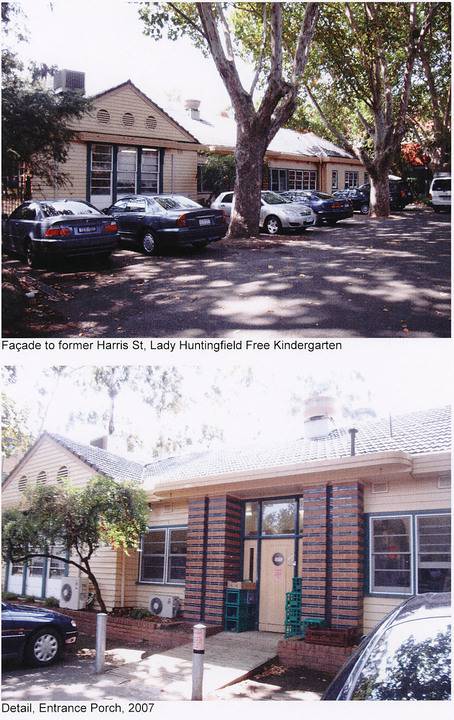| Back to search results » | Back to search page » |
|
Lady Huntingfield Free Kindergarten
Other NameLady Huntingfield Childrens' Centre Location87 - 93 Haines Street,, NORTH MELBOURNE VIC 3051 - Property No B7387
File NumberB7387LevelState |
|
Statement of Significance
What is significant? Lady Huntingfield Free Kindergarten is a purpose-designed '2-unit' kindergarten on a large block of land, built and equipped by Melbourne City Council in 1939-40. The kindergarten was sited in an area of North Melbourne specially selected for its disadvantaged status and surrounded by 'slum' housing. It was intended to provide local children with the advantages of the high-standard Free Kindergarten Union education, health care, nutrition (including midday meals), and family outreach work. By 1940, there were about 9 purpose-built kindergartens in Melbourne, but only 4 of these remain intact today and only the Lady Huntingfield kindergarten represents the new, modern approach in its design.
The building was designed by Eric Beilby, City Council Architect, in 'American Colonial' style. It is a single storey complex with mitred bullnosed weatherboard exterior cladding and a hipped tiled roof. The near symmetrical facade has gabled projections at each end fitted with prominent round timber vents. Its two playroom wings (for younger and older age-groups) have joined banks of low-silled windows facing both north and east, and wide French doors opening to outdoor play spaces. Great care was taken to plan and furnish the building under FKU guidance as a model kindergarten for a maximum of 65 children. Its ancillary rooms included the staffroom with a bayed window projection between the playroom wings, a childrens' dining room, kitchen, medical officer's examination room and records room. The building was sited to maximise sunshine in the playrooms and playgrounds. The playground was greatly enlarged in 1947 when the Council purchased the land fronting Haines St., then occupied by three timber cottages. This significantly increased the early childhood development opportunities provided by the kindergarten for children living in houses with small hard-paved back yards.
Named after Lady Huntingfield, wife of the former Victorian Governor, the kindergarten's local committee was initially composed of influential women connected with Melbourne University and included the Lady Mayoress, ensuring the kindergarten was well supported with fundraising activities. Today, the kindergarten is one of four operated by Melbourne City Council as a long-day child care centre catering for babies up to 5 year old pre-schoolers with a full time kindergarten teaching program. Its refurbished kitchen (originally the Records and Medical consulting rooms) provides daily cooked midday meals for the children at Lady Huntingfield as well as for four other MCC operated childcare/kindergarten centres.
The building is relatively intact despite internal re-arrangements.
How is it significant? The Lady Huntingfield Childrens' Centre is significant for historic, social and architectural reasons at a State level
Why is it significant? Lady Huntingfield kindergarten and its extensive north facing playground is historically and socially significant as the first fully funded municipal kindergarten in Victoria under the Melbourne City Council's Health Plan and claimed by its instigator, Dr. John Dale, to be the first in the British Empire. Dr. John Dale, Melbourne City Council's medical officer of health (1927-1950), was intimately connected with the kindergarten movement and influential in municipal council involvement with infant welfare and pre-school education. It is also significant for its connection and contribution to the well being of generations of North Melbourne pre-school children and their families it has served for nearly 70 years.
The Lady Huntingfield Childrens' Centre is historically and socially significant as one of only six purpose-built kindergartens in Victoria erected prior to 1940 to survive intact and still operate. It is historically significant for its connection with the first 40 years of the kindergarten movement in Victoria and the provision of pre-school education based on Froebel's nurturing ideal and understanding of early childhood development. Together with the other five pre-1940 surviving kindergartens it represents the leading role of the Free Kindergarten Union (now Free Kindergarten Association) from 1908 in establishing kindergartens, raising funds, training teachers, and setting forth enduring principles and standards for kindergartens in Victoria. The deliberate location of early kindergartens in inner-Melbourne suburbs was significant for the educational benefit, improved life chances and social welfare they provided for children of the poor and their mothers. The pre-1940 kindergartens have enduring civic value to the community for their pioneering role in Victorian pre-school education and care of less well-off families.
Lady Huntingfield kindergarten is architecturally and historically significant as the earliest extant modern kindergarten. It departed from the single space all-purpose 'hall' kindergarten design and was the earliest extant '2-unit' kindergarten catering for very young children in a separate playroom. The two playrooms are the first to be provided with continuous banks of windows and large doorways directly to the playgrounds, providing the 'indoor-outdoor' connection seen in many later kindergartens and building types such as houses. The building is also the earliest extant example of a kindergarten with domestic ceiling heights and electric space heating. Its 'American Colonial' weatherboard facade is significant for its domestic scale and reflection of modern popular culture, well suited to a new model kindergarten of 1940. Other significant architectural features are the staffroom bay window, the tapestry brick entrance porch and the large round timber vents in the gable ends. The north facing playground is exceptionally large for a kindergarten.
Classified: 03/12/2007
Group
Education
Category
Infants school




